An Tir Achievement Customs
What is an Achievement?
An 'achievement' is a full formal display of a coat of arms. This form of display is normally used in formal situations, and can be used for decorative elements, banners, and of course on your scrolls. An achievement is your device surrounded by all the extra elements accorded to you by your rank in the SCA. Most of the elements are optional and do not have to be displayed.
The achievement always contains some sort of shield shape, upon which the arms are rendered. It may also contain other elements which surround the shield. The rank of the owner of the arms determines what kind of elements may be used in the achievement. Each Kingdom has its own customs for achievements, and this document only covers those which are found in An Tir.
The basic summary is that there are three levels of awards in the Society. At each level there is a basic set of items you are entitled to display in your achievement, and then some awards carry with them additional items you may display with your achievement.
The first level of award is the Award of Arms level which gives you a helm, torse, and mantling to add to your achievement. A Court Barony carries with it an Award of Arms if the bearer does not already have one, and allows you to display a baronial coronet in your achievement.
The next level is the Grant of Arms level. It is not the custom of the Kingdom of An Tir to give out a Grant of Arms by itself, as it is in other kingdoms. In An Tir orders such as the Jambe de Lion and Goutte de Sang all carry a Grant of Arms with them if the bearer does not already have one (a full list may be found in Kingdom Law). The Grant of Arms level awards adds the option of a crest to top your helm. Each of these orders may be displayed as a medallion in your achievement.
The next level above this is the Patent of Arms level, which must be accompanied by entry into one of the peerage orders. By Society-wide rules the Orders of Chivalry, Laurel, Pelican, and Defense all carry a Patent of Arms. Royal peerages of viscomital, comital and ducal rank may receive a Patent of Arms, if so defined by the laws and customs of the granting Kingdom. At the Patent of Arms level you are given the option of displaying supporters with your achievement, and additional items based on the specific award.
Each of these carries its own set of items of display, which are listed below.
Unranked
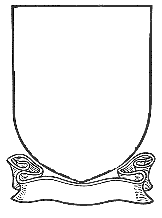
- Escutcheon
- Motto
- Compartment
Award of Arms

- Escutcheon
- Motto
- Compartment
- Helm (dark grey/black)
- Torse
- Mantling
Court Barony
- Everything at Award of Arms level
- May add a pearled coronet of four or six points.
Grant of Arms

- Everything at Award of Arms level
- Crest
- If a member of a grant-bearing order, may add a ribbon around the shield with the badge of the order, or a order chain of linked plates with the badge or representations of the badge of the order. This should avoid looking too much like the livery chain of the Order of Defense.
Patent of Arms
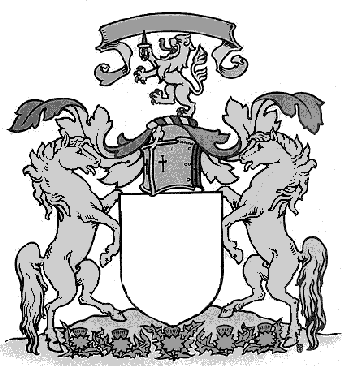
- Everything at Grant of Arms level
- Supporters
- Plus everything for the relevant Order(s) below:
Order of Chivalry
- Knights may bear a gold chain around the shield.
- Masters may bear a white (not silver) baldric around the shield.
Order of the Laurel
- May add a laurel wreath as a crest, surrounding the shield, replacing the torse, or gorging the supporters.
Order of the Pelican
- May add a pelican in her piety (with or without chicks and nest) as a crest
- May add a red chapeau trimmed 'argent plumetty gules, the whole goutty de sang'. (plumed red and white, with a drop of blood on each white plume.)
Order of Defense
- Everything at Patent of Arms level
- May add a white (not silver) livery collar encircling the shield, with the badge of the order depending therefrom.
See Master of Defense Official Order Badge Depictions for guidance.
Royal Peerage
- Everything at Grant of Arms level
- Supporters
- Plus everything for the specific rank below:
Viscount/Viscountess
- May add a coronet. There is no defined SCA-wide or Kingdom-standard viscomital coronet. A pearled coronet of twelve or sixteen points may be used.
Count/Countess
- Helm (silver trimmed in gold)
- Coronet - Gold embattled coronet
At this rank, members of the Order of the Rose may encircle the shield with a wreath of red roses and hearts proper, or a wreath of red roses proper. Alternatively the wreath can be replaced by a gold ribbon, hanging from it a gold medallion bearing a wreath of red roses and hearts proper.
Duke/Duchess
- Helm (gold)
- Coronet - Gold strawberry-leafed coronet
At this rank, members of the Order of the Rose may encircle the shield with a wreath of gold hearts and roses barbed green seeded red or a wreath of roses barbed green seeded red, and a gold strawberry-leaved coronet on top of the wreath. Alternatively the wreath can be replaced by a gold ribbon with a red medallion bearing a wreath of gold roses and hearts, and mantling.
Branches
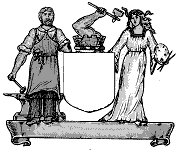
- Everything at Grant of Arms level
- Supporters
- Helm (dark grey/black)
- Mural coronet
- Baronies may use a baronial coronet, or a depiction of their territorial coronet.
- Principalities may use a depiction of their territorial coronet.
- Principalities may use a silver helm.
- The Kingdom will use a depiction of the Crowns of An Tir.
- The Kingdom will use a gold helm.
Guilds and Households
Groups such as guilds and households that have an Award of Arms may display an achievement at the level of Award of arms level (such as helm, mantling, torse, motto and compartment) if they have a registered badge. These groups may display them in an escutcheon format. This follows period practice of period organizations who displayed arms, even though we don't register the group badge as arms.
Groups who do not have an award or arms may display the device badge (if registered) with a motto similar to the level of no award. These groups should not display the badge on an escutcheon, until the group is awarded arms.
Definitions
Helm
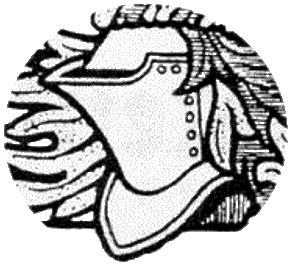 The helm is placed on top of the shield, touching, not floating above it. The style of helm is up to the recipient, and it can be taken from a non-heraldic period for purposes of persona display. Atop the helm can be set torse, crest, and mantling if the bearer is entitled to it by rank. When the helm has a crest the helm should be turned the direction of the crest, i.e. if the crest is a lion's face affronty, then the helm is affronty, and if the crest is a lion passant the helm is facing to dexter.
The helm is placed on top of the shield, touching, not floating above it. The style of helm is up to the recipient, and it can be taken from a non-heraldic period for purposes of persona display. Atop the helm can be set torse, crest, and mantling if the bearer is entitled to it by rank. When the helm has a crest the helm should be turned the direction of the crest, i.e. if the crest is a lion's face affronty, then the helm is affronty, and if the crest is a lion passant the helm is facing to dexter.
Different award levels have different metals/colors:
- Black or dark gray helm - Award of Arms, Grant of Arms, Barony, Court Barony
- Silver helm - Laurel, Pelican, Chivalry, Viscomital rank
- Silver helm trimmed with gold - Comital rank
- Gold helm - Ducal rank
Torse
 This is a twisted cloth roll of usually two colors that holds the mantling on to the helmet. The colors are generally drawn from the main color and metal of the device, just like the mantling.
This is a twisted cloth roll of usually two colors that holds the mantling on to the helmet. The colors are generally drawn from the main color and metal of the device, just like the mantling.
Chapeau
 The chapeau or 'cap of maintenance' is reserved for Pelicans (gules turned up argent plumetty gules, goutty de sang) and can be used in place of the torse or helm.
The chapeau or 'cap of maintenance' is reserved for Pelicans (gules turned up argent plumetty gules, goutty de sang) and can be used in place of the torse or helm.
Coronet
Royal peerages, and landed and court baronies are entitled to use coronets appropriate to their rank in achievements:
- Court Barony - Pearled coronet of four or six points.
- Landed Barony - Pearled coronet of four or six points, or a representation of their territorial coronet.
- Viscomital - There is no defined SCA-wide viscounty coronet and no Kingdom standard either. A pearled coronet of twelve or sixteen points may be used.
- Comital - Gold embattled coronet. (defined SCA-wide)
- Ducal - Gold strawberry-leafed coronet. (defined SCA-wide)
- Branch - A mural coronet of either the English (grey stone embattled and masoned) or German (grey stone embattled and masoned with towers for points) style. To reduce any confusion with a comital coronet, the crowns must be grey stone, and must be obviously masoned.
If an award entitled a coronet, the coronet may be used in place of the torse to hold mantling on the helm. Another form of display is to omit the helm, mantling and crest, and rest the coronet right on top of the shield. When this is done, the coronet extends all the way across the top of the shield and is a major part of the design. The coronet should rest on the top of the shield, and not 'float' above the shield.
Crest
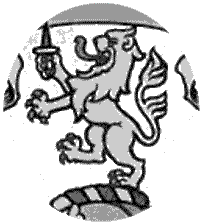 The crest became a medium of heraldic display in tournaments, and has been codified into heraldic achievements since then. A good early period crest is something that could conceivably have been placed on top of a helmet. Later period crests became more fanciful and outlandish.
The crest became a medium of heraldic display in tournaments, and has been codified into heraldic achievements since then. A good early period crest is something that could conceivably have been placed on top of a helmet. Later period crests became more fanciful and outlandish.
Crests should face the same direction the helmet faces.
It was relatively common in some places and times in period for the crest to be the same or derived from as the wearer's fieldless badge. In an achievement using a crest, it is not uncommon for period art to omit the torse, so that the crest just flows seamlessly into the mantling as was shown in early period and German style.
Compartment
 The compartment is an optional piece of 'ground' on which the achievement rests. Any person of any rank may use a compartment. However, based on period artistic, and general aesthetic, practices, they are recommended in achievements using supporters, and not recommended in achievements without them. Supporters look more 'natural' standing on something solid than floating in air, and the piece of ground looks somewhat superfluous in an achievement without supporters.
The compartment is an optional piece of 'ground' on which the achievement rests. Any person of any rank may use a compartment. However, based on period artistic, and general aesthetic, practices, they are recommended in achievements using supporters, and not recommended in achievements without them. Supporters look more 'natural' standing on something solid than floating in air, and the piece of ground looks somewhat superfluous in an achievement without supporters.
Common compartments are grassy hills (sometimes with flowers), a watery ford (when supporters are fish or sea-monsters), or an architectural construct (such as a carved stone platform). Such a platform may also be an area for displaying the motto, as if it were carved in the stone (see Motto). The compartment area may be used for other sorts of heraldic or personal allusion or as seems appropriate to the recipient. For example, a mountain range or a desert plain may represent a person's home area.
Tokens, awards, insignia and artistic elements honoring branch founders can be worked into the overall design of the achievement but it is best to keep the whole achievement simple. If there is a desire to work such things into the design they can easily be put into the compartment area below the shield. There is plenty of artistic room at the bottom to display tokens of awards, or symbols honoring people.
Motto
 Any person of any rank may use a motto. The motto is usually found over the top of the achievement, or underneath the achievement. The motto is generally drawn on a scroll, but may take other forms and be worked into the compartment.
Any person of any rank may use a motto. The motto is usually found over the top of the achievement, or underneath the achievement. The motto is generally drawn on a scroll, but may take other forms and be worked into the compartment.
Mantling
Mantling has its history in the head coverings of knights on crusade, and had been adopted as a form of heraldic display. In earlier period display the mantling consisted of a simple cloth flowing off of the helmet, but in later period display the mantling had become extremely stylized, with multiple cuts in the cloth, and tassels at the ends. Sometimes in later period armory the stylization would take on the form of acanthus leaves, blown ribbons, or other shapes. The mantling should be of a color and metal, usually taken from the primary metal and color of the device.
There are examples of period achievements that flow out of the crest as a complete unit, such as a demi-lion atop a helm with the skin of the lion flowing into a mantling of the helmet.
Shield, or Escutcheon
The shield (also called an escutcheon) referred to here is the shield shape upon which the main display of arms is found. While the standard shield shape for armorial display is the 'heater' shape (like an inverted triangle with rounded sides, similar to the shape of a flatiron 'heater'), other shield shapes have been used for armorial display depending on the place and time of the display. A good survey of these shield shapes over time and place can be found in Neubecker's Heraldry -- Sources, Symbols and Meanings.
In period, women occasionally used a lozenge-shaped shield for armorial display, a practice which was more common in later period than earlier. However, during the majority of the SCA's times and places, women used the same kind of shield, helm, mantling, etc as did men.
Streamer
Streamers are a late period and post-period substitution for mantling, in achievements for women where the arms are drawn on a lozenge-shape rather than a shield shape, and there is no helmet and mantling. They look like ribbons. In most cases in our period, women used the same shield, helm, mantling, etc, forms as did men, and use of streamers is discouraged.
Supporter
 A supporter is a thing or things 'supporting' the shield of the arms. Most often the supporters are animate creatures such as lions, dragons, fish, or humans. There is considerable variation in display of supporters in period depending on the style of the display. There were several types of display involving supporters including formal and artistic. In formal displays the supporters were most often seen in pairs, and in artistic displays the supporters became part of the artwork featuring the arms as a centerpiece.
A supporter is a thing or things 'supporting' the shield of the arms. Most often the supporters are animate creatures such as lions, dragons, fish, or humans. There is considerable variation in display of supporters in period depending on the style of the display. There were several types of display involving supporters including formal and artistic. In formal displays the supporters were most often seen in pairs, and in artistic displays the supporters became part of the artwork featuring the arms as a centerpiece.
When you have a set of supporters, they fall into several categories:
- Human Figures (men, women, angels, armored figures, mer-creatures, savages, etc)
- Beasts (any heraldic animal)
- Birds (used in pairs and singly)
- Inanimate Objects (rare in period, but examples include towers, and trees)
Examples of single supporters include:
- A beast, or fish holding a square or rectangular banner with the arms. (Note: a beast bearing a pennon or standard with a badge displayed is not considered an achievement and is not restricted.)
- The chest of an eagle charged with a shield of the arms. (often seen in Roman and German displays of achievements)
- A human figure (often armored, garbed of an order cloak, or similar regalia) holding a shield, or the shield setting on the ground resting against the leg, with one hand on top to support it.
Sets of supporters do not have to match each other. Earlier in the period when supporters are used they most often match, and in the later end of this period they often do not match. Supporters may have chains around their neck with tokens representing group awards, honors, or what have you, but this practice is discouraged in favor of placing the item on the compartment.
The use of a lion, tail forked and nowed sable as a supporter is restricted to the Kingdom or Royal arms, and to holders of the Honor of the Lion of An Tir and is not available for general use.